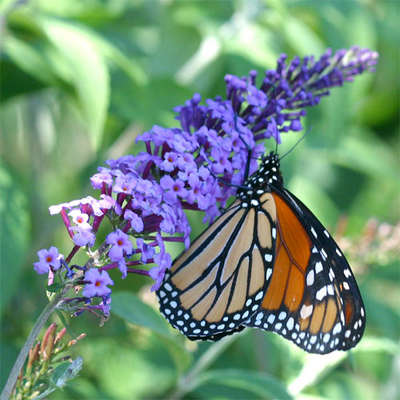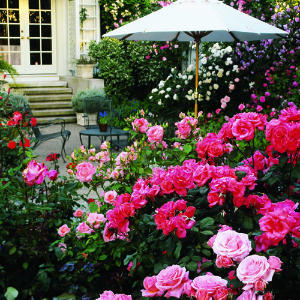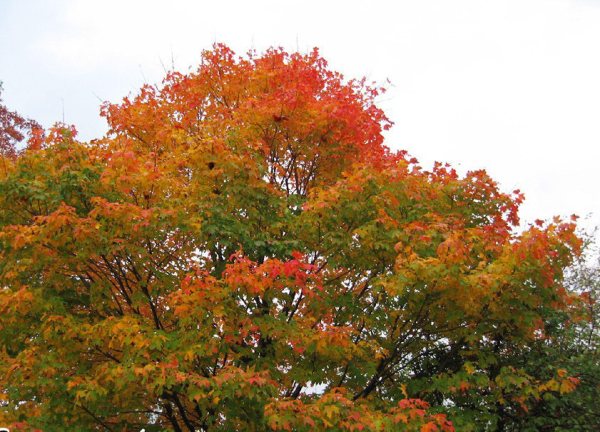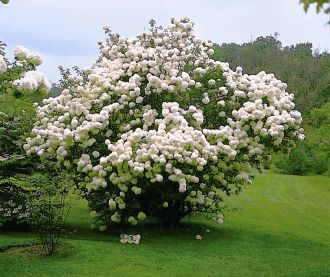|
|
|
Q&A
Ask a Master Gardener |
Very tiny gnats are taking over my house! How can I control them?
Little gnats called "fungus gnats" often hatch from the soil of houseplants. Even though the flying adult gnats can be annoying, the damaging stage is the grub found in the soil around roots. When the eggs laid in the soil around houseplants that were permitted to be outside, perhaps on a shady patio last summer, begin to hatch, the grubs feed on plant roots. Fungus gnats do not cause extensive damage unless there are large numbers. The grubs thrive on water, so allowing plants to dry between watering will help. A safe pesticide, such as Gnatrol® ( Bacillus thuringiensis or Bt), may be applied to the soil as a drench to help with grub control.
We have several large Buddleias, or butterfly bushes, that we would like to prune back. What is the best time to do so and how far can we cut them back?
The beautiful Buddleias (Buddleia davidii) that we enjoy so much and are cherished by so many butterflies as a nectar plant, can be pruned back to three or four inches from the ground. Sometimes though this extensive trimming can cause long and spindly weak limbs that break easily in the wind. So the suggested pruning method is to cut back one third to one half of the shrub. This type of pruning will promote more surface area for blooms, since it blooms on the new wood. Like crape myrtles, it is best to wait until late spring when you see the buds appear to prevent any dieback from late freezes. Click here for more information on how to attract butterflies in your garden. trimming can cause long and spindly weak limbs that break easily in the wind. So the suggested pruning method is to cut back one third to one half of the shrub. This type of pruning will promote more surface area for blooms, since it blooms on the new wood. Like crape myrtles, it is best to wait until late spring when you see the buds appear to prevent any dieback from late freezes. Click here for more information on how to attract butterflies in your garden.
I want to move several shrubs around the garden area. I have several spring blooming shrubs and summer flowering ones, and a few perennials. May I transplant them now?Summer flowering shrubs and perennials can be successfully transplanted now if the ground is not frozen. Transplanting spring flowering shrubs and perennials now might prevent them from flowering because of the shock of the move. The latter group would include Spring flowering Forsythias (Forsythia x intermedia), common lilacs (Syringa vulgaris), Witchhazel (Hamamelis virginiana), Pussy Willow (Salix discolor), Flowering Quince (Chaenomeles speciosa), Azaleas, and Spiraeas. Aside from the lack of flowering, transplanting now should not harm the plant vigor if enough roots are captured and then watered well in the new location. At this time of year, be sure to mulch to prevent root damage in the event of a spring frost.
I am anxious to prune back my hybrid tea roses but I don't want any dieback, so how soon can I begin the process of caring for them? Ultrafine oil is a great oil to spray on your roses in spring to begin the process. There are also organic and nonorganic fungicides available that work well in killing off overwintering fungus spores from blackspot and powdery mildew that you may have had the previous year. Horticultural oils work by smothering the fungus or pests. Spray the entire bush and the surrounding soil. Raking up leaves before you spray is also a good horticultural practice. Pruning wounds are much more susceptible to freeze damage and it is better to wait until mid March to begin pruning. Pruning stimulates new growth and will make your roses more productive bloomers. Rule of thumb for pruning is to first prune out any broken, damaged or diseased canes. Prune out any canes that no longer produce blooms. Any canes that are crossing or rubbing should have the smaller cane removed. And finally, remove any wild or wayward canes that are not pleasing to the eye. Use sharp secateurs or pruning shears; the bypass type usually give a cleaner cut. If you are concerned about spreading fungal spores between bushes, sterilize pruning shears in a solution of one part bleach to ten parts water and then rinse thoroughly. Click here for more information about pruning plants in the Tulsa County area. horticultural practice. Pruning wounds are much more susceptible to freeze damage and it is better to wait until mid March to begin pruning. Pruning stimulates new growth and will make your roses more productive bloomers. Rule of thumb for pruning is to first prune out any broken, damaged or diseased canes. Prune out any canes that no longer produce blooms. Any canes that are crossing or rubbing should have the smaller cane removed. And finally, remove any wild or wayward canes that are not pleasing to the eye. Use sharp secateurs or pruning shears; the bypass type usually give a cleaner cut. If you are concerned about spreading fungal spores between bushes, sterilize pruning shears in a solution of one part bleach to ten parts water and then rinse thoroughly. Click here for more information about pruning plants in the Tulsa County area. |
|
Mark Your Calendar
Annual Master Gardener plant sale. Ask any Master Gardener or Click here for an order form. Deadline for orders is Friday, March 26 and pick up is Thursday, April 15.
Tuesday Evening Gardening Classes start April 6 at the Extension Center on 15th Street. Free. 5:30 to 6:30. Click here for dates and topics.
See the Master Gardeners at the Tulsa Home and Garden Show March 11 thru March 14.
Showcase Garden Tour of six MG gardens, June 26 and 27. |
|
|
 |
Need more information? Click on any of the links below
|
How to Take a Soil Test
How to collect a good sample of soil from your lawn or garden and get it tested at the OSU lab.
Trade names and where to find them
|
 |
4 Ways to Contact Us |
Email us at:
See our website at:
Call us at: 746-3701 from 9-4,
M-F
Visit us at 4116 East 15th Street, Gate 6 at the Fairgrounds
Whether you call or bring samples of plants to the office, trained Master Gardeners will answer your gardening questions with science based information. |
 |
Forward to a friend |
| If you would like to forward this issue of our eNewsletter to a friend, just click the "forward email" at the bottom of the page. | |
|
|
|
|
 |
March Lawn and Garden Tips
|
Garden
Don't forget to order your annual bedding plants from the Master Gardeners. Deadline is March 26. See below for complete details.
- Spring cultivation and addition of organic compost to annual flower and vegetable beds improves the performance of the soil. It adds nutrients as well as helps control winter weeds. However, don't work the soil when it is wet, this damages soil texture.
- Prune roses after March 15. Remove dead canes, prune for shape, better air circulation and to enhance blooming.
- Fertilize roses at pruning time with a slow release, balanced chemical fertilizer. Scratch into soil; keep 6 inches from rose stems. Follow label directions. Too much nitrogen will decrease blooms.
- Horticultural oil spray used in a dormant dosage, can still be applied to control mites, galls, and overwintering aphids in plants susceptible to these pests. Ornamentals such as roses and many fruit trees are examples.
- Spring is the time to divide and replant overcrowded summer and fall blooming perennials such as hostas, daylilies and ornamental grasses.
- Prune your spring blooming shrubs such as azaleas immediately after flowering. Shrubs which bloom in summer (e.g. crapemyrtle) and non-blooming broad leafed evergreens( photinia, boxwood and laurels) are best pruned before spring growth begins.
- Cut back Liriope and other ornamental grasses before spring growth begins. This allows sunlight to enter the plant and creates room for growth. That also is a good time for fertilization.
- A soil test is key to understanding which fertilizer nutrients may be needed for lawns and garden beds or if soil acidity needs adjusting.
- Cool-season vegetables like broccoli, cabbage, carrot, lettuce, onion, peas, etc. should be planted by the middle of March. Start warm-season vegetable transplants indoors.
- Bare root trees and shrubs should be planted February and March to allow root development needed for coping with the heat of summer.
- When planting trees, remember that the hole needs to be wider than deeper. Studies show that your tree will grow three times faster if you mulch around it. Click here for more information on planting trees.
Lawn
- Preemergent herbicides need to be applied before weeds germinate, best done before March 15. Crabgrass germinates when the soil reaches 55 to 60 degrees. To be effective, be sure to irrigate with ˝ inch of water after application. Some preemergents allow a second application 60 days after the first, for more complete coverage. Read the label. Don't apply preemergent on your fescue lawn if you plan to overseed.
- Fertilize your fescue turfgrass once in spring, best by May, with 1 lb. of nitrogen per 1000 square feet. Do not fertilize again until late September and again in November. Use a quick release fertilizer in spring. Don't fertilize Bermuda lawns until fully green in April.
- You can still use glyphosate (Roundup) to spot kill weeds in your Bermuda lawn. Glyphosate won't harm your Bermuda grass as long as it is dormant (brown). Do not use Roundup on dormant zoysia grass.
|
 |
Annual Plant Sale |
|
Annually, Master Gardeners sponsor a plant sale to fund the many Master Gardener volunteer programs. Now is the time to preorder great bedding plants at attractive prices for spring planting. Prepaid orders must be received no later than 4 p.m. Friday, March 26. Plants will be available for pick-up on Thursday, April 15, from 10:00 a.m. to 7:00 p.m.
For more information including order forms, a complete list of plant materials and pictures, click here. This link will take you to the Master Gardener's web site. Be sure to scroll down the web site page to find the order form, names of flowers and a link to photos.
Order forms are available from any Master Gardener, or you can stop by the OSU County Extension Center, 4116 East 15th Street. Order forms will also be available at the Master Gardener booth at the Tulsa Home and Garden Show, March 11-14. |
 |
Oklahoma Proven 2010 |
The Caddo Sugar Maple tree and the Korean Spice shrub were named Oklahoma Proven picks for 2010. Both are well suited for Oklahoma and will provide shade, color and fragrance for the home owner.
Caddo Sugar Maple Acer saccharum caddo
This tree is a native to southwestern Oklahoma and is quite heat and drought tolerant as well as being a tree of low maintenance. It is a beautiful shade tree, growing to a height of more than 30' and a width of 15 to 30'. It likes full sun or partial shade. It's growth rate is moderate (12" to 24" per year). It can be used for shade or as a focal point for fall color. The dark green leaves of summer will change in the fall to various shades of gold and yellow, and sometimes red. It prefers well drained soil, and is tolerant of dry and high pH soils. The tree will grow in USDA Hardiness Zones 5-9 which includes Tulsa. Be sure to check for easement restrictions and electrical lines when planting. growth rate is moderate (12" to 24" per year). It can be used for shade or as a focal point for fall color. The dark green leaves of summer will change in the fall to various shades of gold and yellow, and sometimes red. It prefers well drained soil, and is tolerant of dry and high pH soils. The tree will grow in USDA Hardiness Zones 5-9 which includes Tulsa. Be sure to check for easement restrictions and electrical lines when planting.
Korean Spice Viburnum Virburnum carlesii
This shrub is well suited for this area. It prefers sun or partial shade and likes moist, well drained, slightly acidic soils. It grows 4' to 6' in height and about the same in width. It is hardy in zones 5-7. In the spring the flower buds are pink or red and when flowering they turn white or pink. It is at this time they began emitting a very pleasant fragrance, making them very popular around patios and decks. Summer foliage is dark green turning to wine-red in the fall. The plant also has a small red fruit that turns black in the fall and is attractive to many birds. This shrub makes an excellent border plant or fence line planting. Once established, it becomes very heat and drought tolerant. Several different cultivars are now available. decks. Summer foliage is dark green turning to wine-red in the fall. The plant also has a small red fruit that turns black in the fall and is attractive to many birds. This shrub makes an excellent border plant or fence line planting. Once established, it becomes very heat and drought tolerant. Several different cultivars are now available.
Click here for the complete list, pictures and descriptions of the Oklahoma Proven selections for 2010, as well as for prior years.
|
 |
Tulsa Home & Garden Show |
|
March 11-14
Visit the Master Gardeners at their booth at the Home and Garden Show, March 11-14 at the Quik Trip Center at Expo Square. The theme of this year's exhibit is "Flower Power." Activities will appeal to the young and the young at heart. One of the many highlights on Saturday and Sunday will be a special exhibit from the OSU Entomology Department of live insects of all sizes. Other exhibits will include raised bed gardening, hoop house gardening, and an exhibit of roses in bloom. The first 500 visitors each day will receive a Shumard Oak tree sapling, ready for planting. There will be activities for the kids, as well as a full schedule of seminars for adults. Come visit us! | |
|
|
|
|